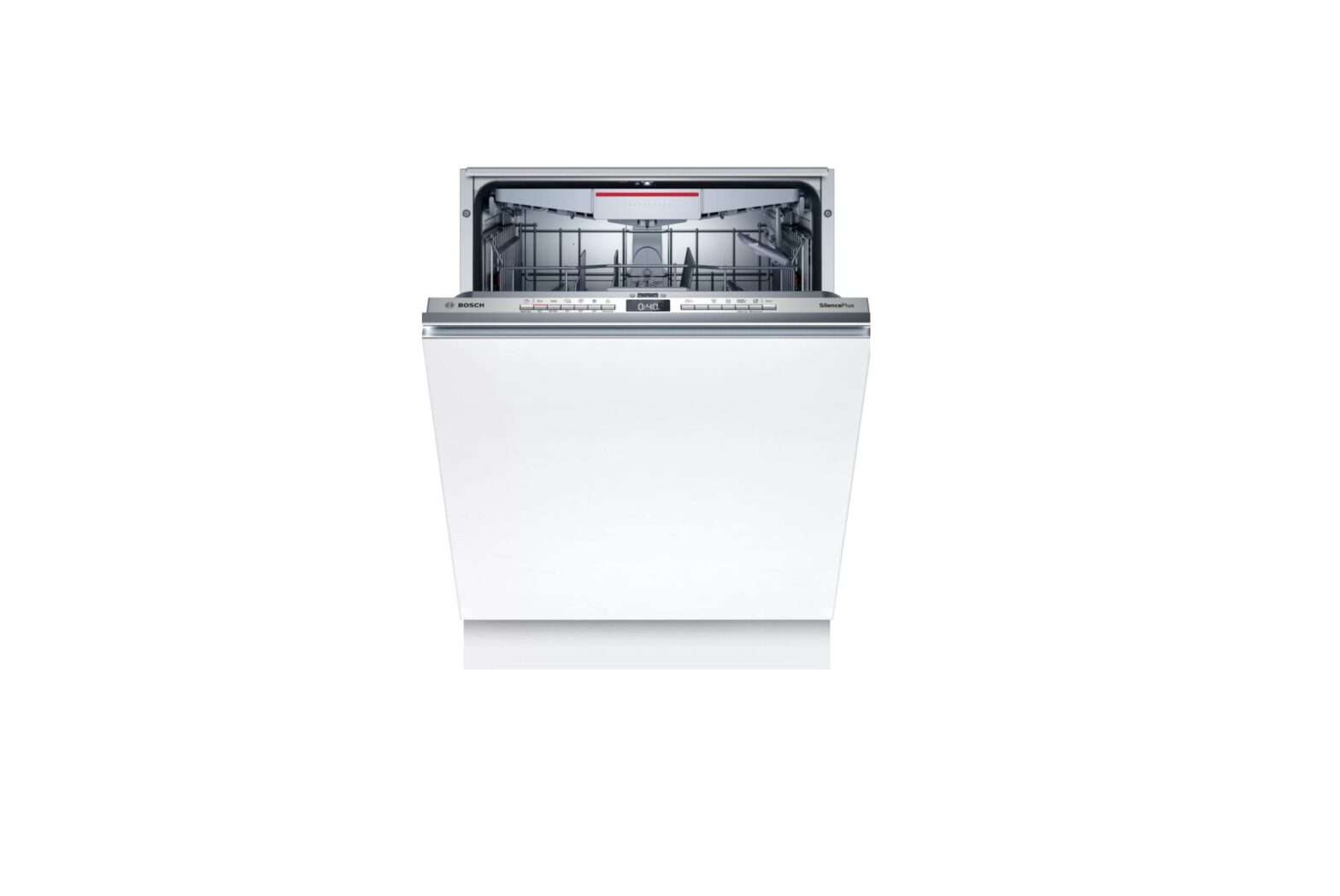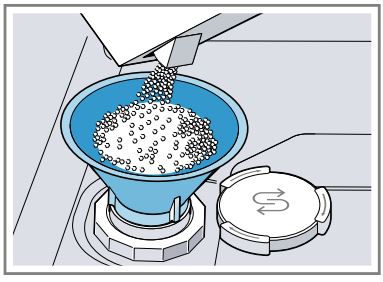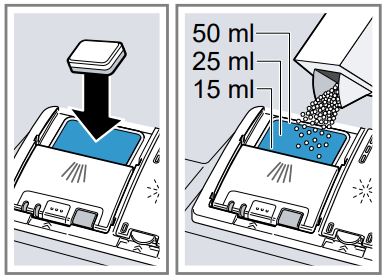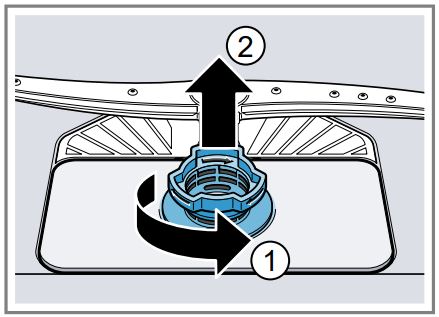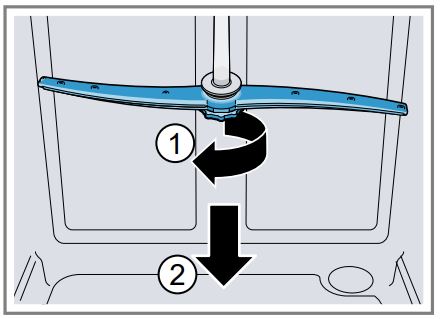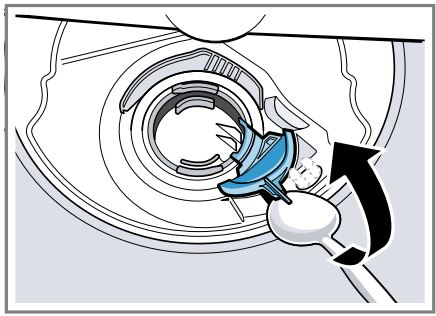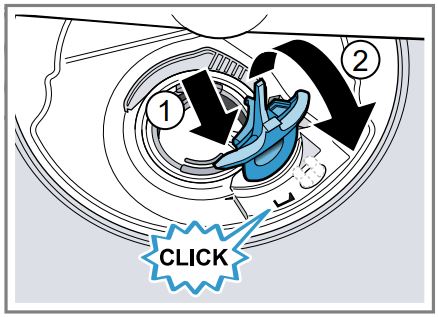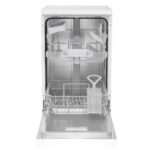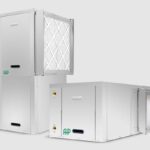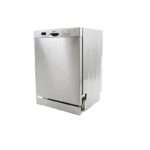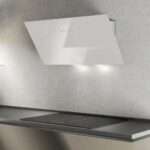BOSCH SGV4HCX48E Dishwasher User Manual
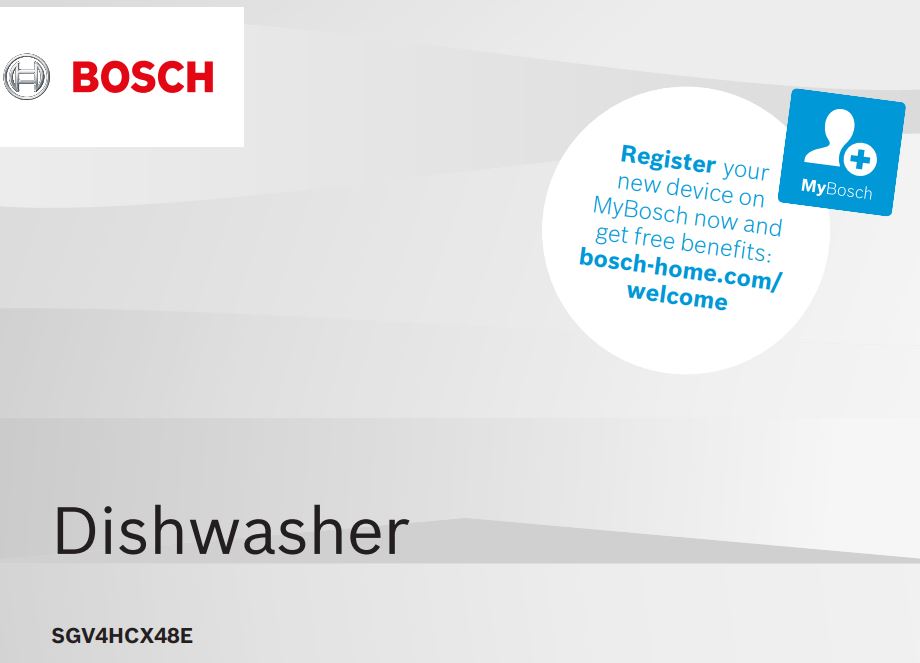
⚠ Safety
Observe the following safety instructions.
General information
- Read this instruction manual carefully.
- Keep the instruction manual and the product information safe for future reference or for the next owner.
- Do not connect the appliance if it has been damaged in transit.
Intended use
Only use this appliance:
- For cleaning household tableware.
- In private households and in enclosed spaces in a domestic environment.
- Up to an altitude of 4000 m above sea level.
Restriction on user group
This appliance may be used by children aged 8 or over and by people who have reduced physical, sensory or mental abilities or inadequate experience and/or knowledge, provided that they are supervised or have been instructed on how to use the appliance safely and have understood the resulting dangers. Do not let children play with the appliance. Cleaning and user maintenance must not be performed by children unless they are being supervised. Keep children under the age of 8 years away from the appliance and power cable.
Safe installation
⚠ WARNING Risk of injury!
Improper installation may cause injury.
When installing and connecting the appliance, follow the instructions in the manual and installation instructions.
⚠ WARNING Risk of electric shock!
- Incorrect installation is dangerous.
- Connect and operate the appliance only in accordance with the specifications on the rating plate.
- Always use the supplied power cable for the new appliance.
- Connect the appliance to a power supply with alternating current only via a properly installed socket with earthing.
- The protective conductor system of the domestic electrical installation must be properly installed.
- Never equip the appliance with an external switching device, e.g. a timer or remote control.
- When the appliance is installed, the mains plug of the power cord must be freely accessible. If free access is not possible, an all-pole isolating switch must be installed in the permanent electrical installation according to the installation regulations.
- When installing the appliance, check that the power cable is not trapped or damaged.
- Cutting through the supply hose or immersing the Aqua-Stop valve in water is dangerous.
- Never immerse the plastic housing in water. The plastic housing on the supply hose contains an electric valve.
- Never cut through the supply hose. The supply hose contains electric power cables.
⚠ WARNING Risk of fire!
- It is dangerous to use an extended power cord and non-approved adapters.
- Do not use extension cables or multiple socket strips.
- Only use adapters and power cords approved by the manufacturer.
- If the power cord is too short and a longer one is not available, please contact an electrician to have the domestic installation adapted.
- Contact between the appliance and installation lines may lead to a defect in these lines, e.g. gas pipes and power lines. Gas from a corroded gas pipe can ignite. A damaged power line can cause a short circuit.
- Check that there is a distance of at least 5 cm between the appliance and installation lines.
⚠ WARNING Risk of injury!
Hinges move when opening and closing the appliance door and can cause injury. If built-under or integrable appliances are not in a cavity so that one side is accessible, the hinge area must be covered at the side. Covers are available from Customer Service or specialist outlets.
⚠ WARNING Risk of tipping!
Improper installation may cause the appliance to tip up. Only install built-under or integrable appliances under a continuous worktop that is securely connected to adjacent cabinets.
Safe use
⚠ WARNING Risk of serious harm to health!
Failure to comply with safety instructions and directions for use on packaging’s of detergent and rinse aid products may cause serious harm to health. Follow the safety instructions and directions for use on the packaging’s of detergent and rinse aid products.
⚠ WARNING Risk of explosion!
- Adding solvents to the interior of the appliance may cause explosions.
- Never add solvents to the interior of the appliance.
- Highly caustic alkaline or highly acidic cleaning agents in conjunction with aluminium parts in the interior of the appliance may cause explosions.
- Never use highly caustic alkaline or highly acidic cleaning agents, in particular commercial or industrial products, in conjunction with aluminium parts (e.g. grease filters of extractor hoods or aluminium pans), e.g. for the Machine Care programme.
⚠ WARNING Risk of injury!
- Leaving the appliance door open may result in injury.
- Only open the appliance door to load or unload tableware in order to prevent accidents, e.g. through tripping.
- Do not sit or stand on the appliance door when open.
- Knives and utensils with sharp points can cause injuries.
- Arrange knives and utensils with sharp points in the cutlery basket with the points downwards, on the knife shelf or in the cutlery drawer.
⚠ WARNING Risk of scalding!
If you open the appliance door while the programme is running, hot water may splash out of the appliance. Open the appliance door carefully if the programme is still running.
⚠ WARNING Risk of electric shock!
- An ingress of moisture can cause an electric shock.
- Only use the appliance in enclosed spaces.
- Never expose the appliance to intense heat or humidity.
- Do not use steam- or high-pressure cleaners to clean the appliance.
- If the insulation of the power cord is damaged, this is dangerous.
- Never let the power cord come into contact with hot appliance parts or heat sources.
- Never let the power cord come into contact with sharp points or edges.
- Never kink, crush or modify the power cord.
Damaged appliance
⚠ WARNING Risk of electric shock!
- If the appliance or the power cord is damaged, this is dangerous.
- Never operate a damaged appliance.
- Never operate an appliance with a cracked or fractured surface.
- Never pull on the power cord to unplug the appliance. Al-ways unplug the appliance at the mains. If the appliance or the power cord is damaged, immediately unplug the power cord or switch off the fuse in the fuse box and turn off the water tap.
- “Call customer services.” Page 52
- Incorrect repairs are dangerous.
- Repairs to the appliance should only be carried out by trained specialist staff.
- Only use genuine spare parts when repairing the appliance.
- If the power cord of this appliance is damaged, it must be replaced with a special connection cable, which is available from the manufacturer or his Customer Service.
Risk to children
⚠ WARNING Risk of suffocation!
- Children may put packaging material over their heads or wrap themselves up in it and suffocate.
- Keep packaging material away from children.
- Do not let children play with packaging material.
- Children may breathe in or swallow small parts, causing them to suffocate.
- Keep small parts away from children.
- Do not let children play with small parts.
- Children may become trapped in the appliance and suffocate.
- Use the childproof lock if fitted.
- Never let children play with or operate the appliance.
⚠ WARNING Risk of harm to health!
Children can lock themselves in the appliance, thereby putting their lives at risk. With redundant appliances, unplug the power cord. Then
cut through the cord and damage the lock on the appliance door beyond repair so that the appliance door will no longer close.
⚠ WARNING Risk of crushing!
With higher-level appliances, children can become crushed between the appliance door and cabinet doors underneath. Keep an eye on children when opening and closing the appliance door.
⚠ WARNING Risk of chemical burns!
Rinse aid and detergent may cause chemical burns to the mouth, throat and eyes. Keep children away from detergent and rinse aid products. Keep children away from the appliance when open. The water in the interior of the dishwasher is not drinking water. It may contain residues of detergents and rinse aid.
⚠ WARNING Risk of injury!
Children may get their fingers caught in the slots of the tablet collecting tray and injure themselves. Keep children away from the appliance when open.
Preventing material damage
Safe installation
ATTENTION!
- Improper installation of the appliance may cause damage.
- If the dishwasher is installed above or below other domestic appliances, follow the information on installation in combination with a dishwasher in the installation instructions for the individual appliances.
- If there is no information or if the installation instructions do not include the relevant information, contact the manufacturer of these appliances to check that the dishwasher can be installed above or below these appliances.
- If no information is available from the manufacturer, the dishwasher should not be installed above or below such appliances. To ensure the safe operation of all domestic appliances, continue following the installation instructions for the dishwasher.
- Do not install the dishwasher under a hob.
- Do not install the dishwasher near heat sources, e.g. radiators, heat storage tanks, ovens or other appliances that generate heat.
- Contact between the appliance and water pipes may lead to corrosion of these pipes, possibly causing them to leak.
- Check that there is a distance of at least 5 cm between the appliance and the water pipe. The pipes supplied for the drinking water and waste water connections are not affected here.
- Modified or damaged water hoses may result in material damage and damage to the appliance.
- Never kink, crush, modify or cut through water hoses.
- Only use the water hoses supplied with the appliance or genuine spare hoses.
- Never re-use water hoses that have been used before.
- If the water pressure is too high or too low, the appliance may not be able to operate properly. Make sure that the water pressure in the water supply system is min. 50 kPa (0.5 bar) and max. 1000 kPa (10 bar). If the water pressure exceeds the maximum value specified, a pressure-reducing valve must be installed between the drinking water connection and the hose set of the appliance.
Safe use
ATTENTION!
- Escaping water vapour can damage fitted units.
- When the programme ends, leave the appliance to cool down for a while before opening the door.
- Special salt for dishwashers can damage the tub due to corrosion.
- To make sure that any special salt that escapes is washed out of the tub, add the special salt to the dispenser for special salt immediately before the programme starts.
- Detergent may damage the water softening system.
- Only fill the dispenser of the water softening system with special dishwasher salt.
- Unsuitable cleaning agents may damage the appliance.
- Do not use a steam cleaner.
- So as not to scratch the finish on the appliance, do not use sponges with a rough surface or abrasive cleaning agents.
- To prevent corrosion, do not use sponge cloths on dishwashers with a stainless steel front or rinse such cloths thoroughly several times before using them for the first time.
Environmental protection and saving energy
Disposing of packaging
The packaging materials are environmentally compatible and can be recycled. Sort the individual components by type and dispose of them separately.
Saving energy
If you follow these instructions, your appliance will use less electricity and less water.
Use the Eco 50 ° programme. The Eco 50 ° programme is energy-efficient and environmentally friendly. “Programmes”, Page 17
If you do not have much tableware to wash, use the additional Half Load function.1
The programme will adjust to a lower load and consumption will be reduced. “Additional functions”, Page 19
Aqua Sensor
The AquaSensor is an optical measuring device (light barrier) which measures the turbidity of the rinsing water. You can save water with the AquaSensor. Use of the AquaSensor depends on the programme. If the soiling level is high, the rinsing water is drained off and replaced with fresh water. If the soiling level is lower, the rinsing water is used in the next wash cycle, so reducing water consumption by 3-6 litres. In the automatic programmes the temperature and run time are additionally adjusted to the level of soiling.
Installation and connectionion
To ensure proper operation, connect Installation and connection the appliance to the power and water supply correctly. Observe the specified criteria and the installation instructions.
Scope of supply
After unpacking all parts, check for any damage in transit and completeness of the delivery. If you have any complaints, contact the dealer who sold you the appliance or our Customer Service.
Note: The appliance has been tested at the factory to check it is in working order. It is possible that water has left marks on the appliance. These marks will disappear after the first wash cycle. The delivery consists of the following:
- Dishwasher
- Operating instructions
- Installation Instructions
- Further information documents
- Installation material
- Steam guard plate
- Salt filling aid funnel
- Mains cable
- Quick reference guide
Installing and connecting the appliance
You can position your built-under or integrable appliance in a fitted kitchen between wooden and plastic walls. If you subsequently install your dishwasher as a free-standing appliance, you must stop it from tipping over, e.g. by screwing it to the wall or installing it under a continuous worktop that is securely connected to adjacent cabinets.
- “Follow the safety instructions.” Page 4
- . “Follow the instructions for electrical connection.” Page 13
- Check the Scope of supply and the condition of the appliance.
- Consult the installation instructions for the installation dimensions required.
- Make the appliance level using the height-adjustable feet. Make sure that the appliance is standing on the floor securely.
- “Install the drainage connection.” Page 12
- “Install the drinking water connection.” Page 12
- Connect the appliance to the power supply.
Drainage connection
Connect your appliance to drainage connection so dirty water is discharged via the wash cycle.
Installing the drainage connection
- Consult the installation instructions supplied for the steps required here.
- Connect the wastewater hose to the outlet connection of the siphon using the enclosed parts.
- When doing so, check that the wastewater hose is not kinked, crushed or twisted.
- Also check that there is no cover in the drainage system preventing the wastewater from being discharged.
Drinking water connection
Connect your appliance to a drinking water connection.
Installing the drinking water connection
Note
- If you are replacing the appliance, you must use a new water supply hose.
- Consult the installation instructions supplied for the steps required here.
- Connect the appliance to the drinking water connection using the enclosed parts. Observe the “Technical data” Page 53.
- When doing so, check that the drinking water connection is not kinked, crushed or twisted.
Electrical connection
Connecting the appliance to the electricity supply Notes
- Please follow the “Safety instructions” Page 4.
- Connect the appliance to alternating current only, in the range of 220 – 240 V and 50 Hz or 60 Hz.
- Please note that the water safety system is only functional if there is a power supply.
- Insert the non-heating appliance plug of the power cable into the appliance.
- Insert the mains plug of the appliance into a nearby socket. The connection data for the appliance can be found on the rating plate.
- Check that the mains plug is inserted properly.
Familiarising yourself with your appliance
Appliance
You can find an overview of the parts of your appliance here.
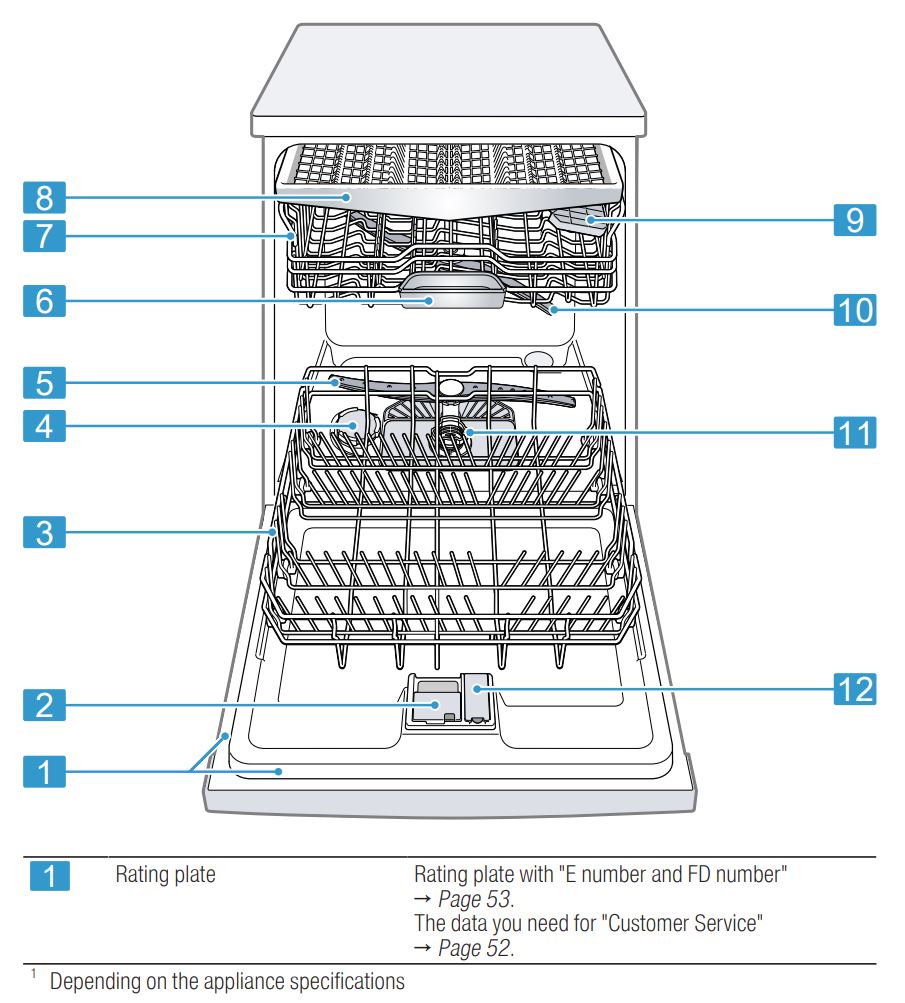

Controls
You can use the control panel to configure all functions of your appliance and to obtain information about the operating status. With some buttons you can perform different functions.
Familiarising yourself with your appliance
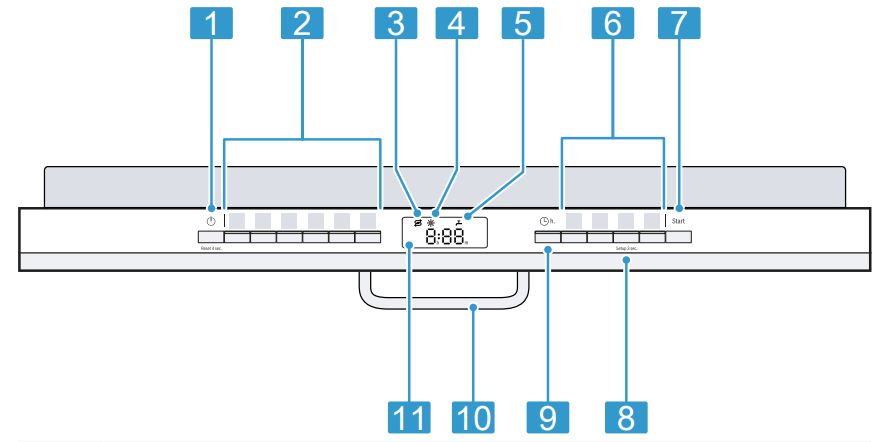
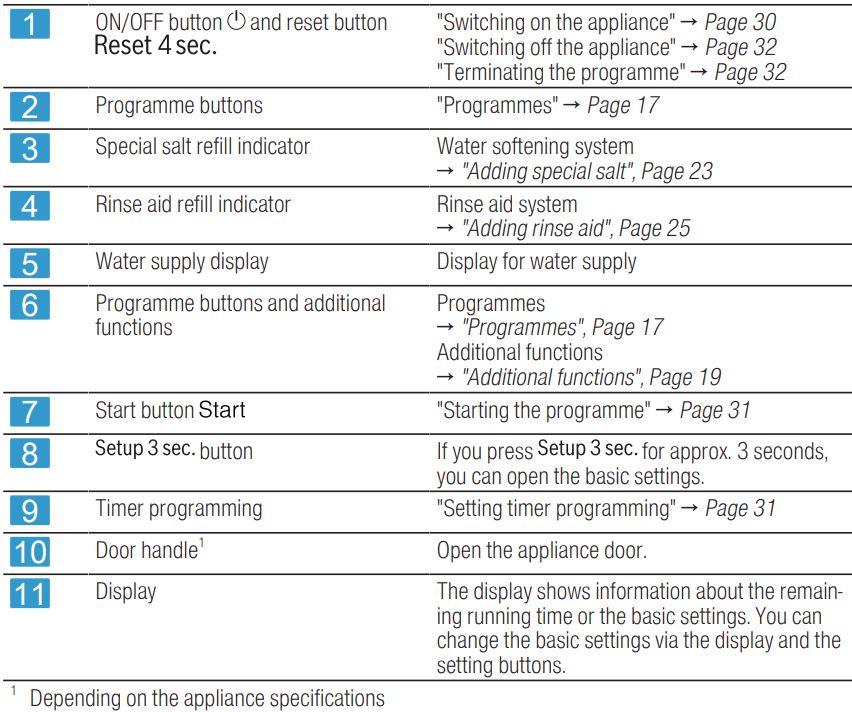
Programmes
You Programmes can find an overview of the programmes that can be selected here. Different programmes, which can be found on the control panel of your appliance, are available depending on the appliance configuration. The running time may vary depending on the programme selected. The running time depends on the water temperature, the quantity of tableware, the level of soiling and the additional function selected. The runtime will change if the rinse aid system is switched off or rinse aid needs to be added. The consumption values can be found in the quick reference guide. The consumption values relate to normal conditions and a water hardness of 16 – 20 °E. Different influencing factors such as water temperature or pipe pressure may result in deviations.
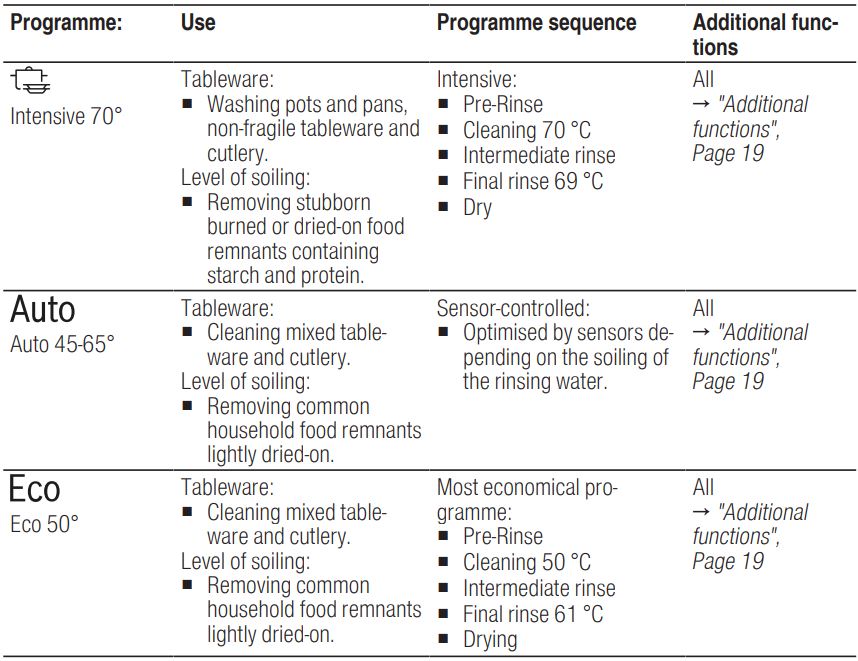
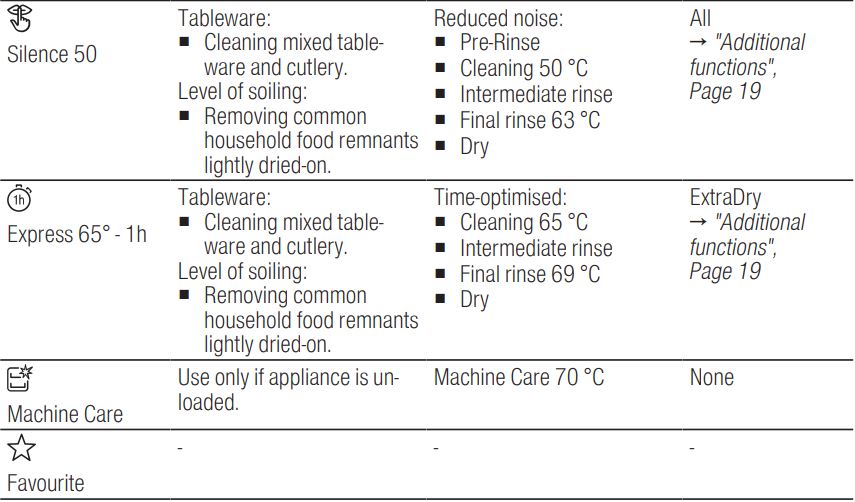
Note: The relatively long running time in the Eco 50 ° programme is due to longer soaking and drying times. This results in optimal consumption values.
Information for test institutes
Test institutes are provided with information for comparability tests, e.g. according to EN60436. These are the conditions for conducting the tests, however they are not the results or consumption values. E-mail enquiries to: [email protected] The product number (E-Nr.) and the production number (FD) are required here. They can be found on the rating plate on the appliance door.
Favourite
You can save a combination of a programme and an additional function to the button. The pre-rinse program is saved to this button at the factory. Pre-rinse is suitable for all types of tableware. The tableware undergoes intermediate cleaning via cold rinsing.
Save Favourite on the appliance.
- Open the appliance door.
- Press .
- Press the right programme button. “Programmes”, Page 17
- Press the button for the relevant additional function. “Additional functions”, Page 19
- Press for 3 seconds. a The selected programme and the additional function will flash. flashes.
The programme and the additional function are saved.
Tip: To reset the programme, reset your appliance back to the factory settings. “Overview of basic settings”, Page 33
Additional functions
You can find an overview of the additional functions that can be selected here. Different additional functions, which can be found on the control panel of your appliance, are available depending on the appliance configuration.


Features
You Features can find an overview of the possible features of your appliance and how to use them here. These features depend on the model of your appliance.
Top basket
Arrange cups, glasses and small items of tableware in the top basket.
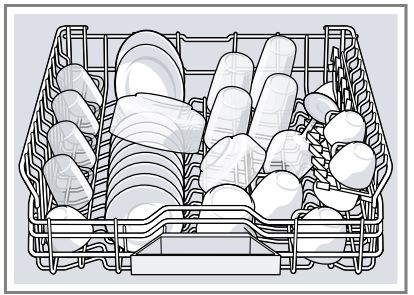
You can adjust the height of the top basket to make room for larger items of tableware.
Adjusting top basket with side levers
To wash large items of tableware in the baskets, adjust the shelf position of the top basket.
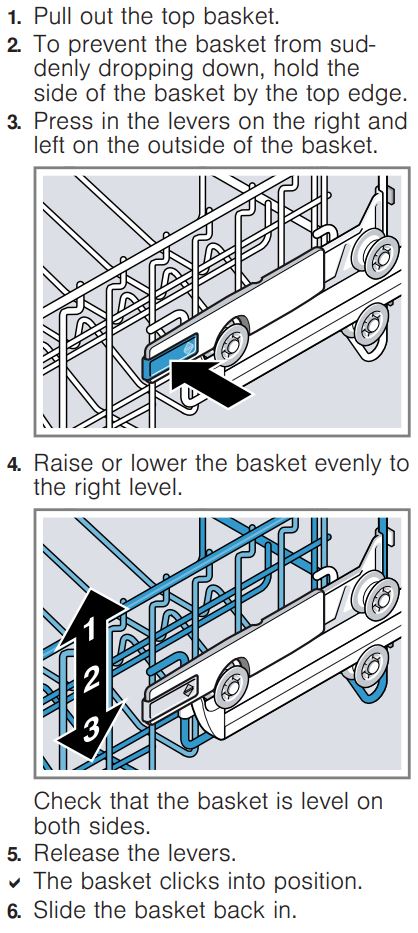
Bottom basket
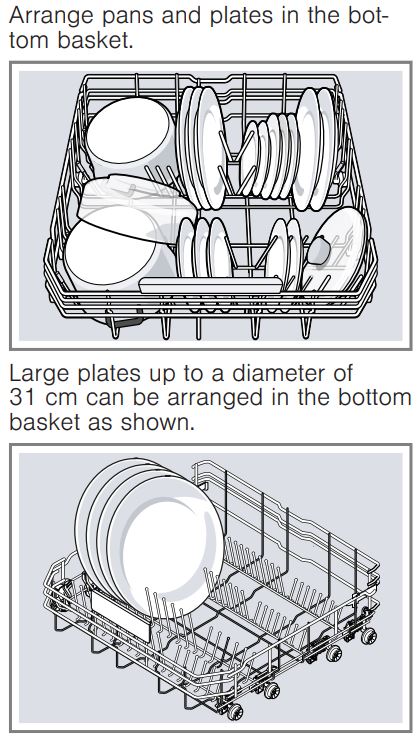
Cutlery drawer
Arrange cutlery in the cutlery drawer.

Etagere
Use the cutlery shelf and space underneath for small cups and glasses or for large items of cutlery, e.g. cooking spoons or serving cutlery.
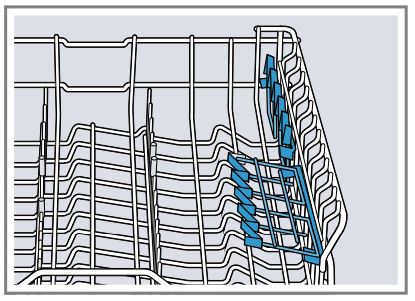
If you do not need the cutlery shelf, you can fold it up.
Folding prongs
Use the folding prongs to position tableware securely, e.g. plates.
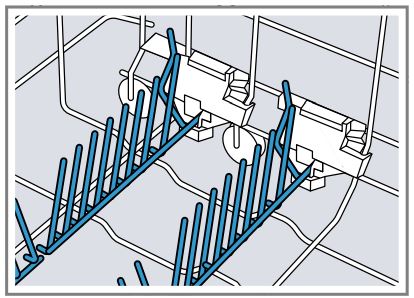
You can fold the prongs down to position pans, bowls and glasses
better.
Folding down prongs1
If you do not need the prongs, fold them down.
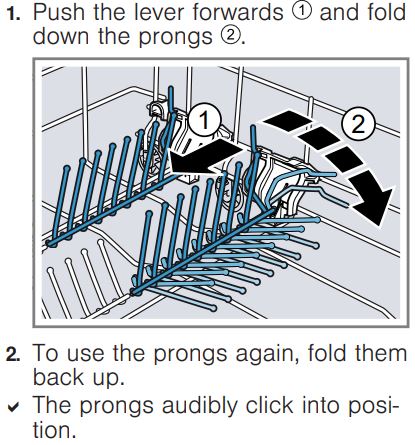
Basket heights
Set the baskets at the right height.
Appliance height 81.5 cm with cutlery drawer

Before using for the first time
Performing the initial configuration
On initial start-up or after a reset to the factory settings, you will need to make settings. Requirement: “The appliance has been installed and connected.” Page 11
- “Add special salt.” Page 23
- “Add rinse aid.” Page 25
- “Switch on the appliance.” Page 30
- “Setting the water softening system.” Page 23
- “Set the amount of rinse aid to be dispensed.” Page 25
- “Add detergent” Page 26.
- Start the Programme with the highest cleaning temperature without tableware. To remove any marks from water or other residues, we recommend you operate the appliance without tableware before using it for the first time.
Tip: You can change these settings and other “Basic settings” Page 33 at any time.
Water softening system
Hard water leaves limescale on the Water softening system tableware as well as the washing tank and parts of the appliance may become blocked. To ensure good dishwashing results, you can treat the water with special salt and the water softening system. To avoid damage to the appliance, water with a hardness above 9 °E must be softened.
Overview of water hardness settings
You can find an overview of the water hardness values that can be selected here. You can find out how hard your water is from your local water company or by using a water hardness tester.


Note: Set the water hardness determined on your appliance. “Setting the water softening system”, Page 23 With a water hardness of 0 – 8 °E you can dispense with special salt for dishwashers and switch off the water softening system. “Switching off the water softening system”, Page 24
Setting the water softening system
Set the water hardness on your appliance.
- Determine the water hardness and the appropriate setting value. “Overview of water hardness settings”, Page 22
- Press .
- To open the basic settings, press for 3 seconds.
The display shows Hxx.
The display shows . - Press repeatedly until the right water hardness has been set. The value H04 is set at the factory.
- To save the settings, press for 3 seconds.
Special salt
You can use special salt to soften water.
Adding special salt
If the special salt refill indicator lights up, add special salt to the dispenser for special salt just before the programme starts. The consumption of special salt depends on the water hardness. The higher the water hardness, the greater the consumption of special salt.
ATTENTION!
- Detergent may damage the water softening system.
- Only fill the dispenser of the water softening system with special dishwasher salt.
- Special salt for dishwashers can damage the tub due to corrosion.
- To make sure that any special salt that escapes is washed out of the tub, add the special salt to the dispenser for special salt immediately before the programme starts.
- Unscrew the lid of the dispenser for special salt and remove.
- On initial start-up: Fill the dispenser right up with water.
- Note: Only use special salt for dishwashers. Do not use salt tablets. Do not use table salt. Add the special salt to the dispenser. Fill the dispenser right up with special salt. The water in the dispenser is displaced and forced out.

- Place the lid back on the dispenser and turn to close.
Switching off the water softening system
If you find the special salt refill indicator irritating, e.g. when using combined detergents with salt replacement substances, you can switch the indicator off.
Note To avoid damage to the appliance, only switch off the water softening system in the following cases:
The water hardness is max. 26 °E and you are using combined detergents with salt replacement substances. According to manufacturers, combined detergents with salt replacement substances can generally only be used up to a water hardness of 26 °E without adding special salt.
The water hardness is 0 – 8 °E. You do not need to use special salt.
- Press .
- To open the basic settings, press for 3 seconds.
a The display shows Hxx. a The display shows . - Press repeatedly until the display shows H00.
- To save the settings, press for 3 seconds.
a The water softening system is switched off and the salt refill indicator is deactivated.
Regeneration of the water softening system
In order to obtain fault-free function of the water softening system, the appliance performs regeneration of the water softening system at regular intervals. Regeneration of the water softening system takes place before the end of the main rinse cycle in all programmes. It will increase the run time and consumption values, e.g. water and electricity.
Overview of consumption values with regeneration the water softening system Here you can find an overview of the maximum additional run time and consumption values during regeneration of the water softening system.
Regeneration of the water softening 6 system after x rinse cycles
Additional run time in minutes 7
Additional water consumption in 5 litres
Additional power consumption in 0.05 kWh
The consumption values specified are laboratory measurements determined in accordance with the currently applicable standard and using the Eco 50° programme and the factory value of the water hardness is set to 16 – 20°E.
Rinse aid system
Rinse aid
For optimum drying results, use rinse aid. Only use rinse aid for domestic dishwashers.
Adding rinse aid
If the rinse aid refill indicator lights up, top up with rinse aid. Only use rinse aid for domestic dishwashers.
- Press the catch on the lid of the dispenser for rinse aid and lift .

- Add rinse aid up to the max mark.
- If rinse aid spills out, remove it from the tub. Spilled rinse aid can cause excessive frothing during the wash cycle.
- Close the lid of the dispenser for rinse aid.
a The lid clicks into position.
Setting the amount of rinse aid
If there are streaks or water marks on tableware, change the amount of rinse aid.
- Press .
- To open the basic settings, press for 3 seconds.
a The display shows Hxx.
a The display shows . - Press repeatedly until the display shows the value set at the factory r05.
- Press repeatedly until the right amount of rinse aid has been set.
- A low setting adds less rinse aid during the wash cycle and reduces streaking on tableware.
- A higher setting adds more rinse aid during the wash cycle, reduces water marks and improves the drying result. - To save the settings, press for 3 seconds.
Switching the rinse aid system off
If you find the rinse aid refill indicator irritating, e.g. when using combined detergents with a rinse aid component, you can switch the rinse aid system off.
Tip: The function of rinse aid is limited with combined detergents. You will generally get better results using rinse aid.
- Press .
- To open the basic settings, press for 3 seconds.
The display shows Hxx.
The display shows . - Press repeatedly until the display shows the value set at the factory r05.
- Press repeatedly until the display shows r00.
- To save the settings, press for 3 seconds.
a The rinse aid system is switched off and the rinse aid refill indicator is deactivated.
Detergent
Suitable detergents
Only use detergents that are suitable for dishwashers. Both separate and combined detergents are suitable. For optimum washing and drying results, use separate detergent, adding “Special salt” Page 23 and “Rinse aid” Page 25 separately. Modern, powerful detergents mainly use a low-alkaline formulation with enzymes. Enzymes break down starch and remove protein. Oxygen based bleaching agents are generally used to remove coloured marks, e.g. tea or ketchup. Note: Follow the manufacturer’s instructions for each detergent.
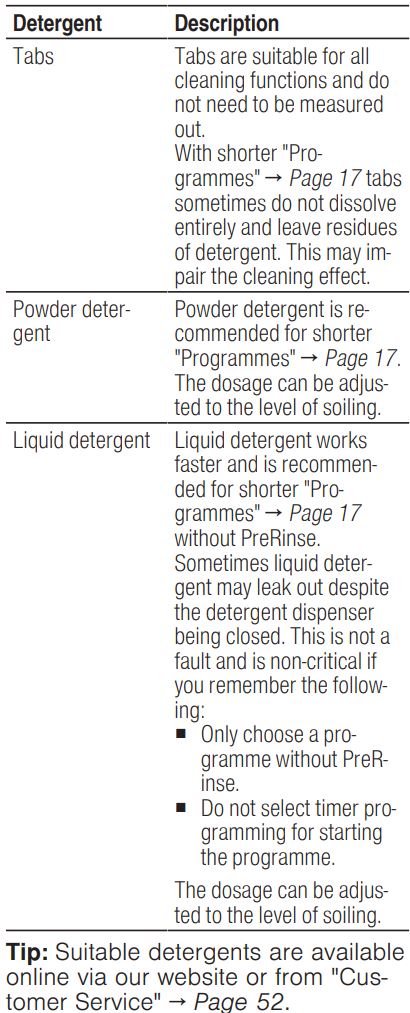
Separate detergents
Separate detergents are products that do not contain components other than detergent, e.g. powder detergent or liquid detergent. With powder and liquid detergent the dosage can be individually adjusted to the level of soiling of the tableware. For better washing and drying results and to avoid damage to the appliance, please additionally use “Special salt” Page 23 and “Rinse aid” Page 25.
Combined detergent
Besides conventional separate detergents, a number of products are available with additional functions. These products contain not only detergent but also rinse aid and salt replacement substances (3in1) and, depending on the combination (4in1, 5in1, …), additional components such as glass protection or stainless steel cleaner. According to manufacturers, combined detergents generally only function up to a water hardness of 26 °E. With a water hardness above 26 °E you will need to add special salt and rinse aid. For the best washing and drying results we recommend using special salt and rinse aid from a water hardness of 17 °E. If you are using combined detergent, the washing programme is adjusted automatically to ensure the best possible washing and drying result.
Unsuitable detergents
Do not use detergent which could cause damage to the appliance or present a risk to health.
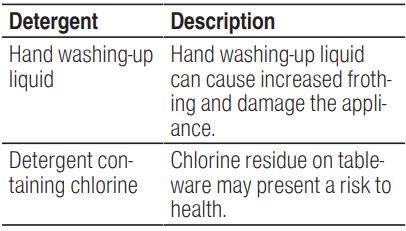
Information on detergents
Follow the instructions on detergents in everyday use.
- Detergents marked as “organic” or “ecological” (environmentally friendly) generally contain lower levels of active agents or completely dispense with certain substances. The cleaning effect may be restricted here.
- Set the rinse aid and the water softening system to the separate detergent or combined detergent in use.
- According to manufacturers, combined detergents with salt replacement substances can only be used up to a certain water hardness, usually 26 °E, without adding special salt. For the best washing and drying results we recommend using special salt from a water hardness of 17 °E.
- To prevent sticking, only touch detergents in a water-soluble pouch with dry hands and only ever place them in a dry detergent dispenser.
- Even if the rinse aid and special salt refill indicators light up, washing programmes will run properly with combined detergents.
- The function of rinse aid is limited with combined detergents. You will generally get better results using rinse aid.
- Use tablets with a special drying performance.
Adding detergent
- To open the detergent dispenser, press the locking latch.
- Add the detergent to the dry detergent dispenser.

If you are using tablets, one is enough. Insert the tablets in a horizontal position. If you are using powder or liquid detergent, follow the manufacturer’s instructions and quantities for dosage in the detergent dispenser. 20 ml 25 ml detergent is sufficient for normal soiling. If tableware is only lightly soiled, slightly less than the amount of detergent specified is usually sufficient. - Close the lid of the detergent dispenser.
a The lid clicks into position.
The detergent dispenser will open automatically at the optimum time during the programme. Powder or liquid detergent will spread around the washing tank and dissolve there. Tablets will fall into the tablet collecting tray and dissolve in the right dosage. In order to ensure that tablets can dissolve evenly, do not place any other objects in the tablet collecting tray.
Tip: If you use powder detergent and select a program with pre-rinse, you can also add a little detergent to the interior door of the appliance.
Tableware
Only Tableware clean tableware that is suitable for dishwashers.
Note: Decorated glassware and parts made of aluminium or silver may fade or discolour with dishwashing. Delicate types of glass may turn cloudy after a few washing cycles.
Damage to glass and tableware
Only put glasses and china in the dishwasher if it is marked as dishwasher-safe by the manufacturer. Avoid damage to glass and tableware.
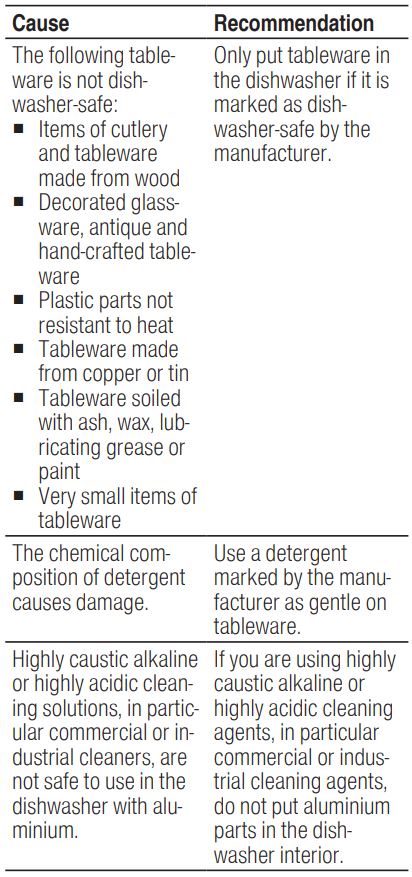
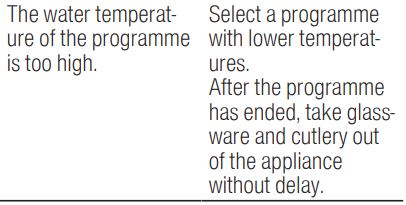
Arrange tableware
Arrange tableware correctly to optimise the dishwashing result and prevent damage to both the appliance and tableware.
Tips
- Using the appliance allows you to save energy and water compared to washing-up by hand.
- See our website for examples of how to load your appliance efficiently, free of charge.
- To save energy and water, load the machine with the number of place settings specified (standard load with tableware and cutlery). “Technical specifications”, Page 53
- For better washing and drying results, position items with curves or recesses at an angle so water can run off.
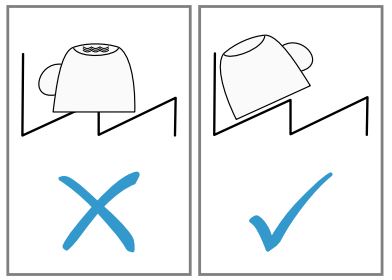
- Remove large remnants of food from tableware.
To save resources, do not premise tableware under running water. - Observe the following when arranging tableware:
- Put heavily soiled tableware in the bottom basket, e.g. pans. The more powerful the spray jet, the better the dishwashing result will be.
- To prevent damage to tableware, arrange it so it is stable and cannot tip over.
- To prevent injury, arrange cutlery with the points and sharp edges facing down.
- Position containers with the openings facing down so no water can collect in them.
- Do not block the spray arms make sure that they can turn freely.
- Do not place small parts in the tablet collecting tray and do not block it with tableware so as not to obstruct the lid of the detergent dispenser.
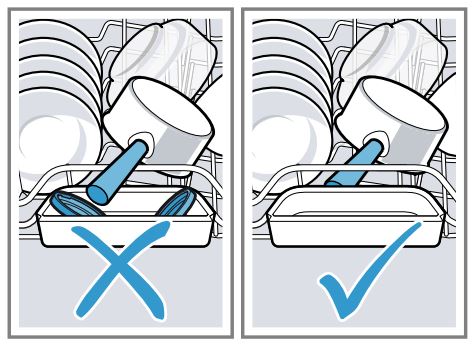
Removing tableware
⚠ WARNING Risk of injury!
Hot tableware can cause burns to the skin. When hot, tableware is sensitive to shock, may crack and can result in injury. When the programme has ended, do not empty the appliance until the tableware has cooled down for a while.
- To prevent water dripping on the tableware, unload it starting at the bottom and working up.
- Check the washing tank and accessories for soiling and clean if necessary. “Cleaning and servicing”, Page 34
Basic operation
Switching on the appliance
Press . The Eco 50° programme is set by default. The Eco 50° programme is especially environmentally friendly and ideal for normally soiled tableware. It is the most efficient programme for the combination of energy/water consumption for this type of tableware and evidences conformity with the EU Ecodesign Directive. If you do not perform any actions on the appliance for 10 minutes, the appliance will automatically switch off.
Setting a programme
To adjust the wash cycle to the soiling level of the tableware, select a suitable programme. Press the right programme button.
“Programmes”, Page 17 a The programme is set and the programme button flashes. a The remaining running time of the programme appears on the display.
Setting additional functions
You can set additional functions to complete the washing programme selected. Note: The additional functions which can be used depend on the programme selected. “Programmes”, Page 17 Press the button for the relevant additional function. “Additional functions”, Page 19 a The additional function is set and the additional function button flashes.
Setting timer programming
You can delay the start of the programme by up to 24 hours.
- Press . a “h:01” appears in the display.
- Use to set the required start time for the programme.
- Press . a This activates timer programming.
Tip: To deactivate timer programming, press repeatedly until “h:00” appears in the display.
Starting the programme
Press . a The programme has ended when
the display shows “0h:00m”.
Notes
- If you want to add more tableware while the appliance is running, do not use the tablet collecting tray as a handle for the top basket. You might touch the partially dissolved tablet.
- You can only change a programme when running if you cancel it. “Terminate programme”, Page 32
- The appliance switches off automatically 1 minute after the end of the programme to save energy. If you open the appliance door immediately after the programme has ended, the appliance will switch off after 4 seconds.
Interrupting programme
Note: When you open the appliance door once the appliance has heated up, leave the door slightly ajar for a few minutes and then close it. This will help prevent excess pressure building up in the appliance and stop the appliance door bursting open.
- Open the appliance door carefully.
- Press . a The programme is saved and the appliance switches off.
- Press to resume the programme.
- Close the appliance door.
Terminate programme
To end a programme early or to switch from a programme that has already started, you will need to cancel it first.
- Open the appliance door.
- Press for approx. 4 seconds.
- Close the appliance door.
a All displays light up.
a As soon as the displays are off, the display shows “0h:01m” and the residual water is pumped out. a The programme is cancelled and ends after approx. 1 minute.
Switching off appliance
- Please note the information on “Safe use” Page 10.
- Press .
Tip: If you press during the wash cycle, the programme currently running will be interrupted. When you switch the appliance back on, the programme continues automatically.
Basic settings
You can configure the basic settings for your appliance to meet your needs.
Overview of basic settings
The basic settings depend on the features of your appliance.

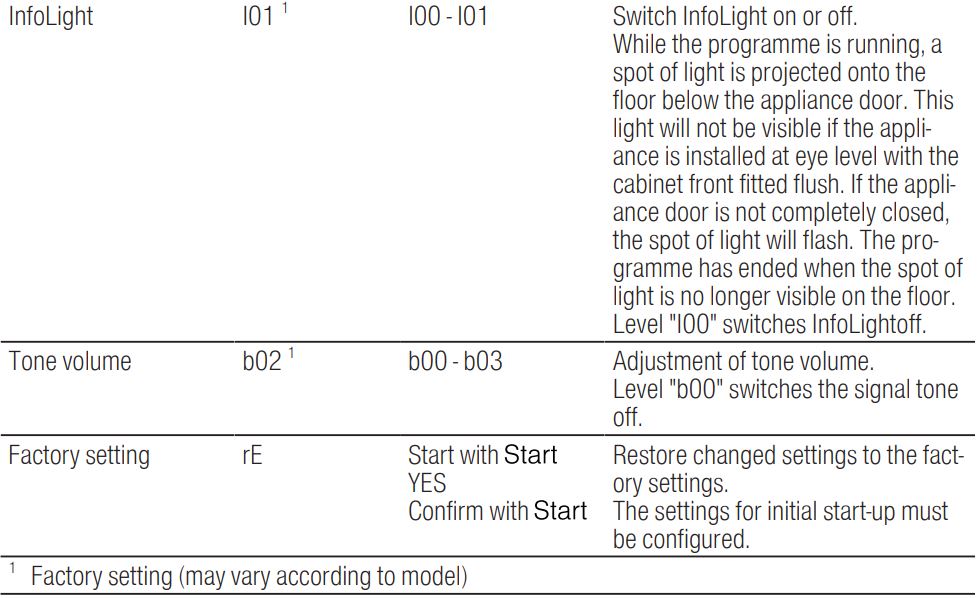
Changing basic settings
- Open the appliance door.
- Press .
- To open the basic settings, press for 3 seconds.
a The display shows Hxx.
a The display shows . - Press repeatedly until the display shows the required setting.
- Press repeatedly until the display shows the right value. You can change several settings.
- To save the settings, press for 3 seconds.
- Close the appliance door.
Cleaning and servicing
To keep your appliance working efficiently for a long time, it is important to clean and maintain it carefully.
Cleaning the tub
⚠ WARNING Risk of harm to health!
Using detergents containing chlorine may result in harm to health. Never use detergents containing chlorine.
- Remove any coarse soiling in the interior with a damp cloth.
- Add detergent to the detergent dispenser.
- Select the programme with the highest temperature. “Programmes”, Page 17
- “Start the programme without tableware.” Page 31
Cleaning products
Only use suitable cleaning products to clean your appliance. “Safe use”, Page 10
Tip: You can get our tested and approved Dishwasher Care and Machine Cleaner for Dishwashers online at https://www.bosch-home.com/ store or from customer service.
Tips on appliance care
Follow the tips on appliance care to make sure your appliance functions properly at all times.
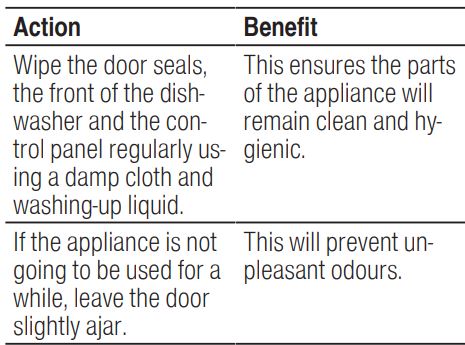
Machine Care
Deposits, e.g. from remnants of food and limescale, can cause your appliance to malfunction. To avoid such faults and reduce odours, we recommend cleaning your appliance at regular intervals. Machine Care combined with machine care products and machine cleaners is the right programme for the care of your appliance.
Tip: You can get our tested and approved Dishwasher Care and Machine Cleaner for Dishwashers online at https://www.bosch-home.com/ store or from customer service. Machine Care is a programme which removes various deposits in one washing cycle. Cleaning takes place in two phases:

To ensure optimum cleaning performance, the programme doses the detergents independently of each another during the relevant cleaning phase. Correct placement of the detergents is necessary here. Run Machine Care without tableware if the indicator for Machine Care lights up on the control panel or if advised to do so by the display. The indicator will go out after you have run Machine Care. If your appliance does not have a reminder function, we recommend performing Machine Care every 2 months.
Running Machine Care Notes
- Run the Machine Care programme without any tableware in the dishwasher.
- Only use machine care products and machine cleaners specially designed for dishwashers.
- Make sure that there are no aluminium parts, e.g. extractor hood grease filters or aluminium pans, in the interior of the appliance.
- If you have not run Machine Care after 3 washing cycles, the indicator for Machine Care will go out automatically.
- For optimum cleaning performance, ensure the correct placement of cleaners.
- Follow the safety instructions given on the packaging’s of the machine care products and machine cleaners.
- Remove any coarse soiling in the interior with a damp cloth.
- Clean the filters.
- Place the machine care product in the appliance interior. Only use machine care products specially designed for dishwashers.
- Pour the machine cleaner into the detergent dispenser until it is filled completely. Do not place any additional machine cleaner in the appliance interior.
- Press .
- Press . a Machine Care is run. a Once the programme has ended, the indicator for Machine Care goes out.
Filter system
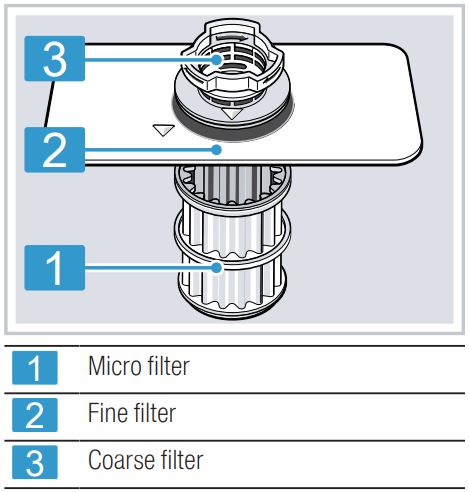
Cleaning filters
Soiling in the dishwashing water may block the filters.
- After each wash check the filters for residue.
- Turn the coarse filter anticlockwise and remove the filter system . Check that no foreign objects fall into the sump.

- Pull down the micro filter to remove.
- Press the locking catches together and lift the coarse filter out .

- Clean the filter elements under running water. Carefully clean the rim of dirt between the coarse and the fine filter.
- Re-assemble the filter system. Make sure that the locking catches on the coarse filter click into position.
- Insert the filter system into the appliance and turn the coarse filter clockwise. Make sure that the arrow markings match up.
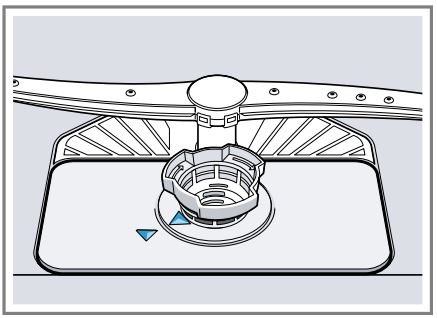
Cleaning spray arms
Limescale and soiling in the dishwashing water may block the nozzles and bearings on the spray arms. Clean the spray arms regularly.
- Unscrew the upper spray arm and pull down to remove .

- Pull up the lower spray arm to remove.

- Check the outlet nozzles on the spray arms for blockages under running water and remove any foreign bodies.
- Insert the lower spray arm. a The spray arm clicks into position.
- Insert the upper spray arm and screw it firmly in place.
Troubleshooting
You Troubleshooting can rectify minor faults on your appliance yourself. Read the troubleshooting information before contacting after-sales service. This will avoid unnecessary costs.
⚠ WARNING Risk of electric shock!
Incorrect repairs are dangerous. Repairs to the appliance should only be carried out by trained specialist staff. Only use genuine spare parts when repairing the appliance. If the power cord of this appliance is damaged, it must be replaced with a special connection cable, which is available from the manufacturer or his Customer Service.
Error code / Fault display / Signal

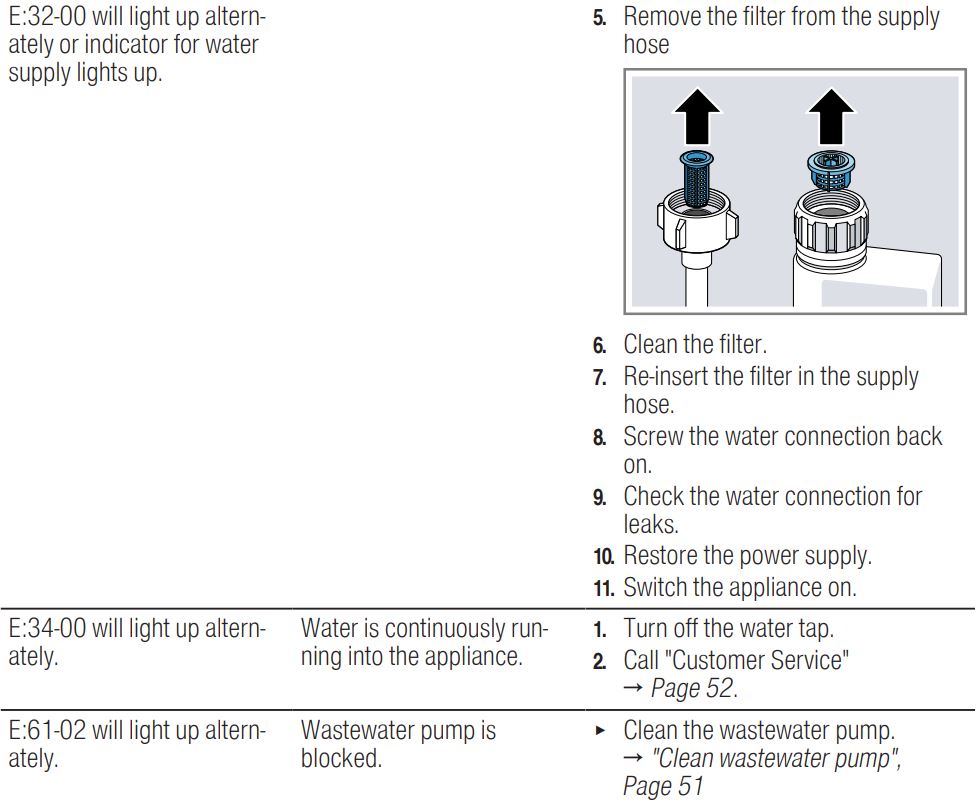

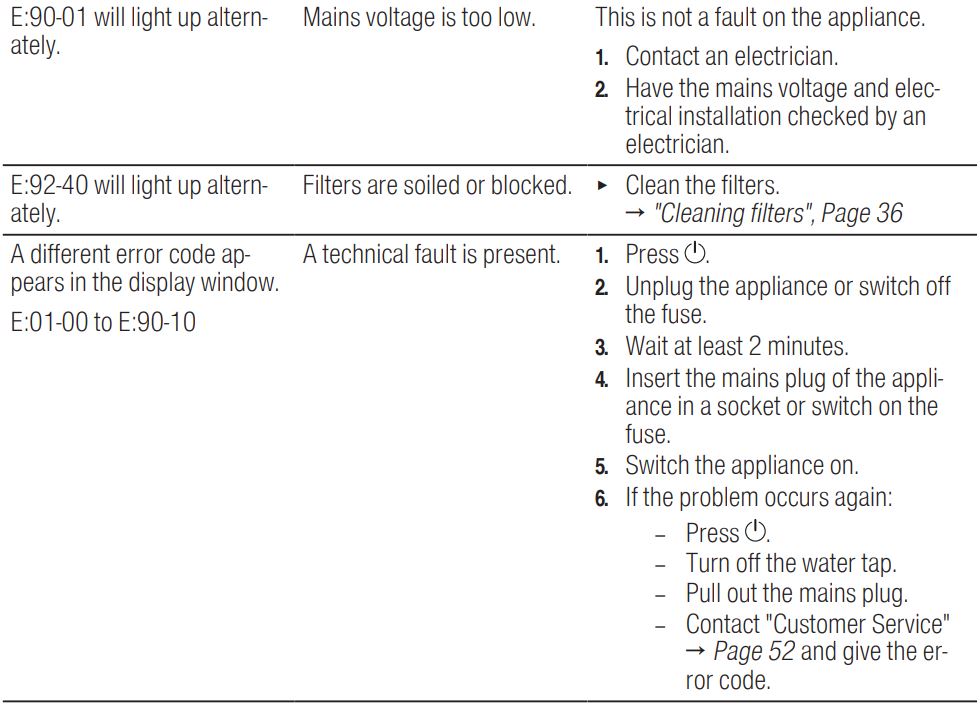
Washing results
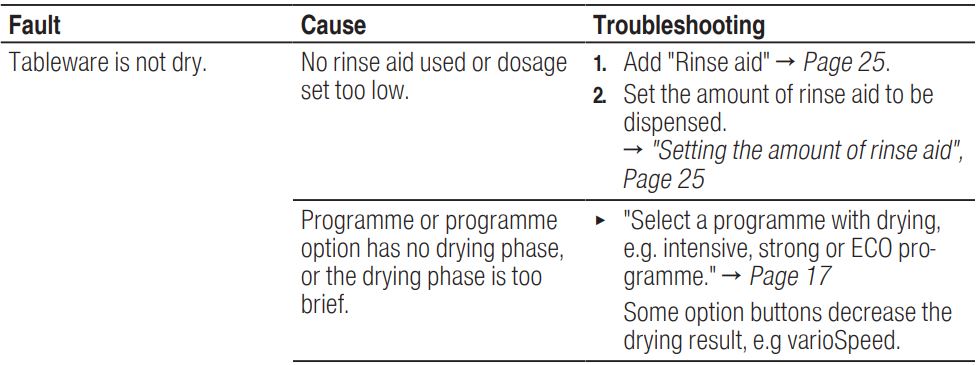
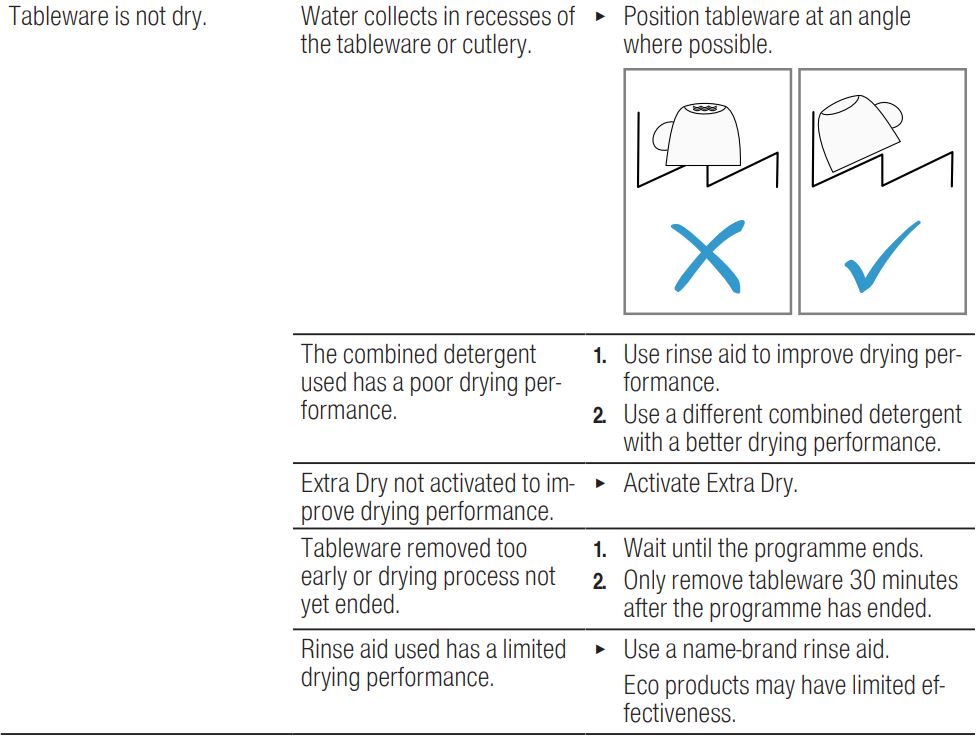
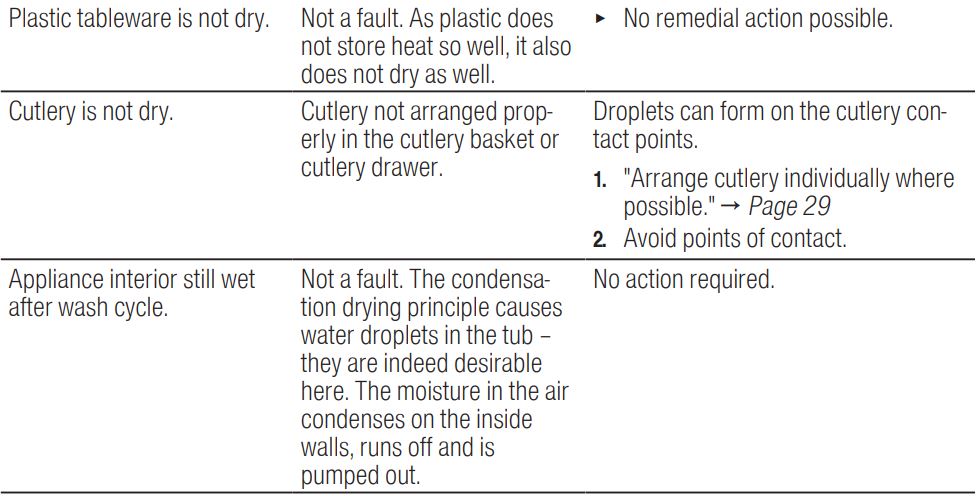

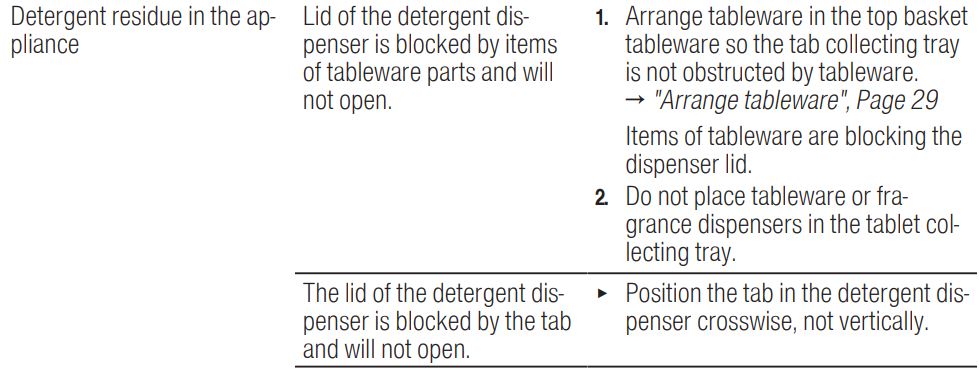
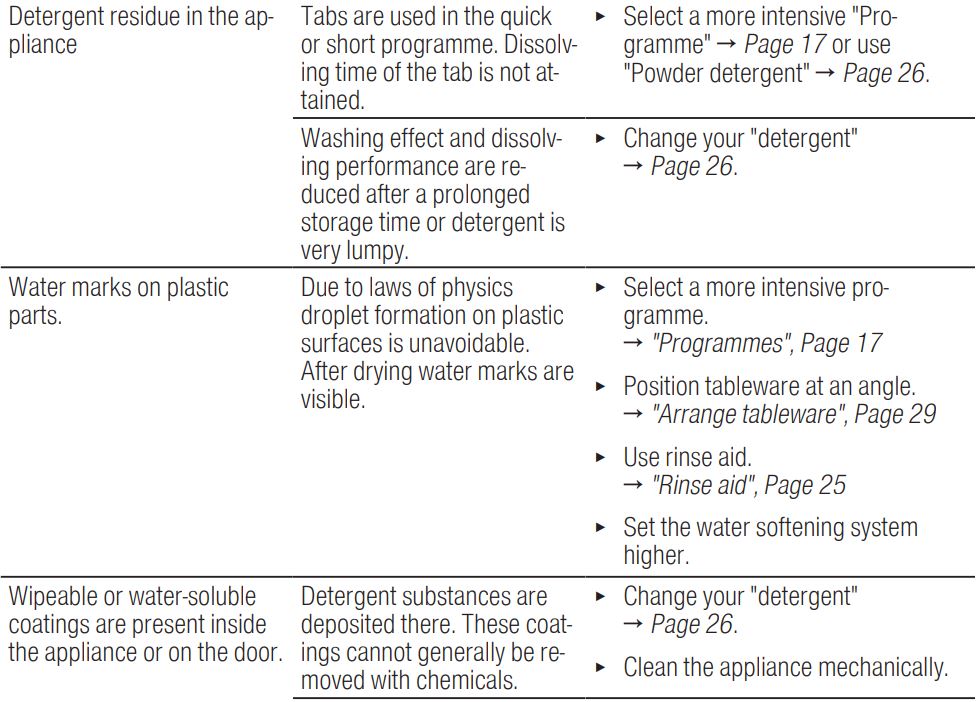
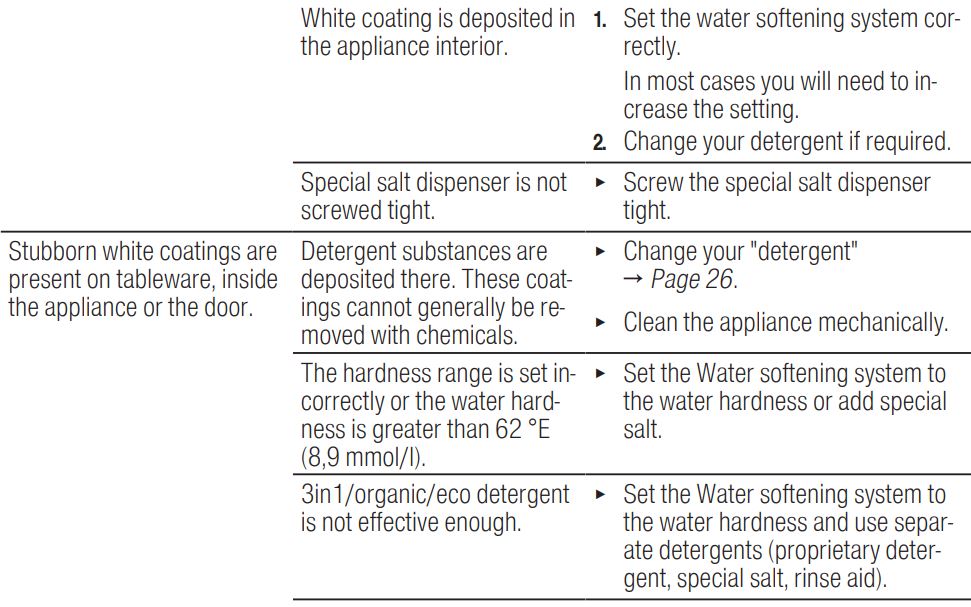
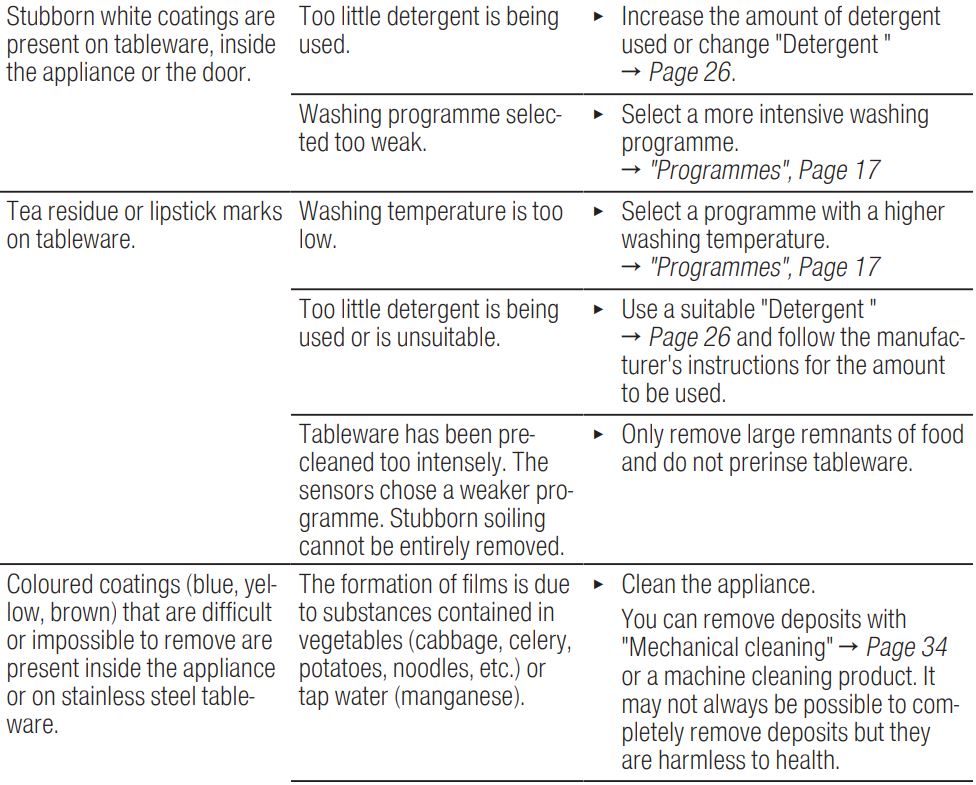

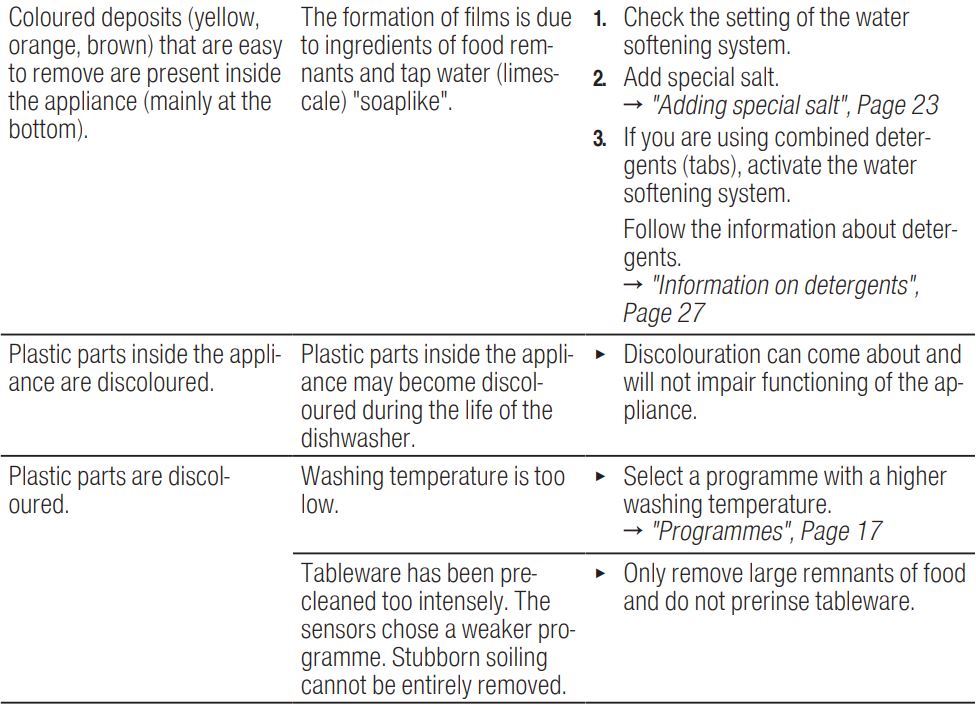
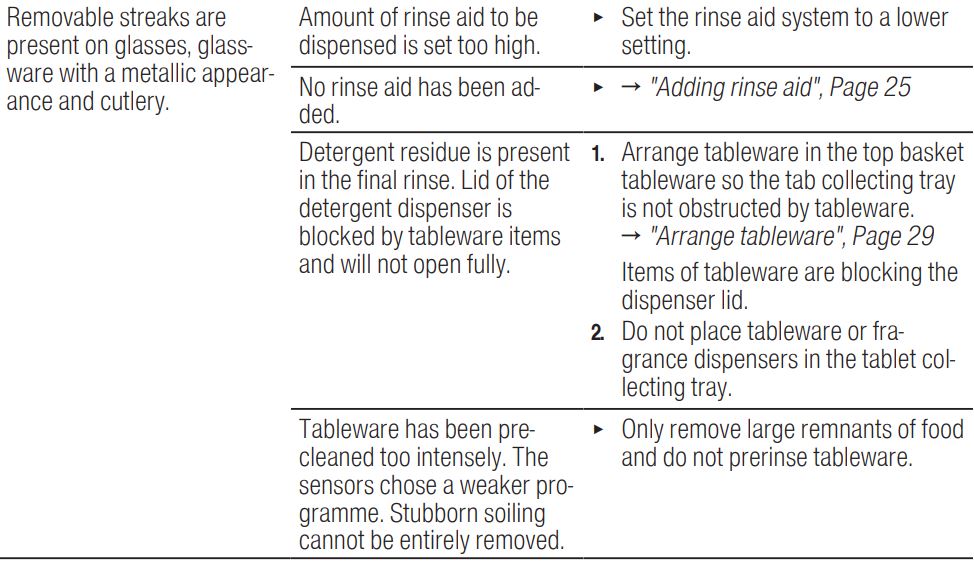
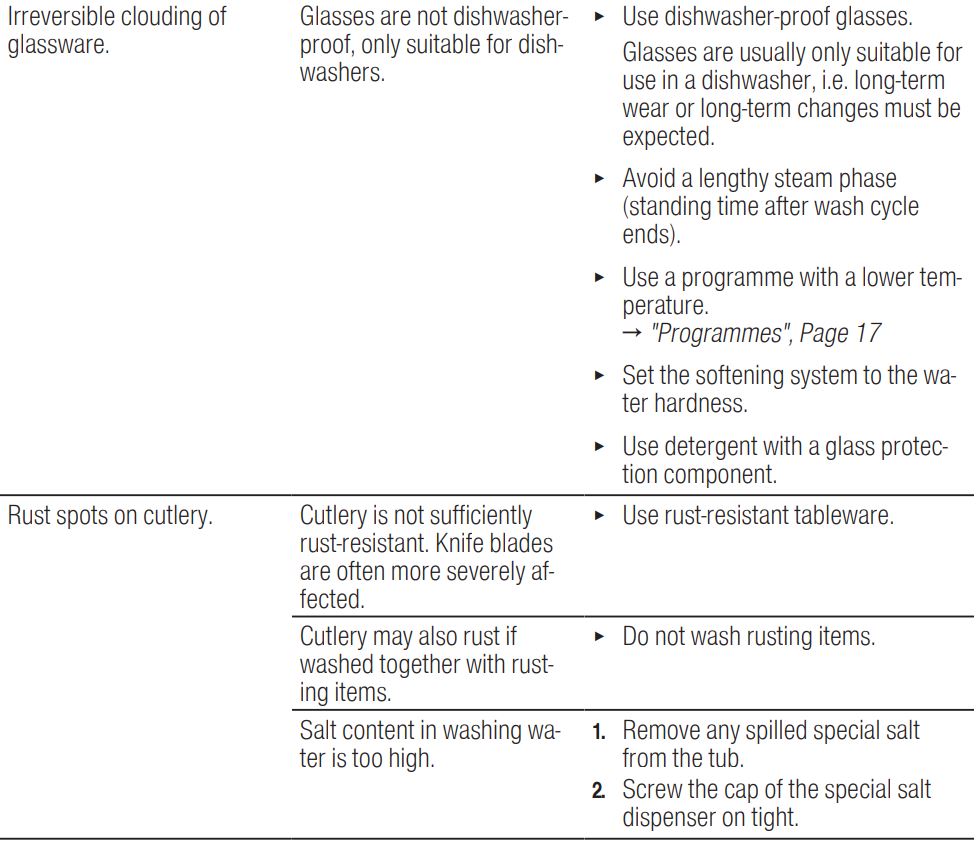

Information on display panel
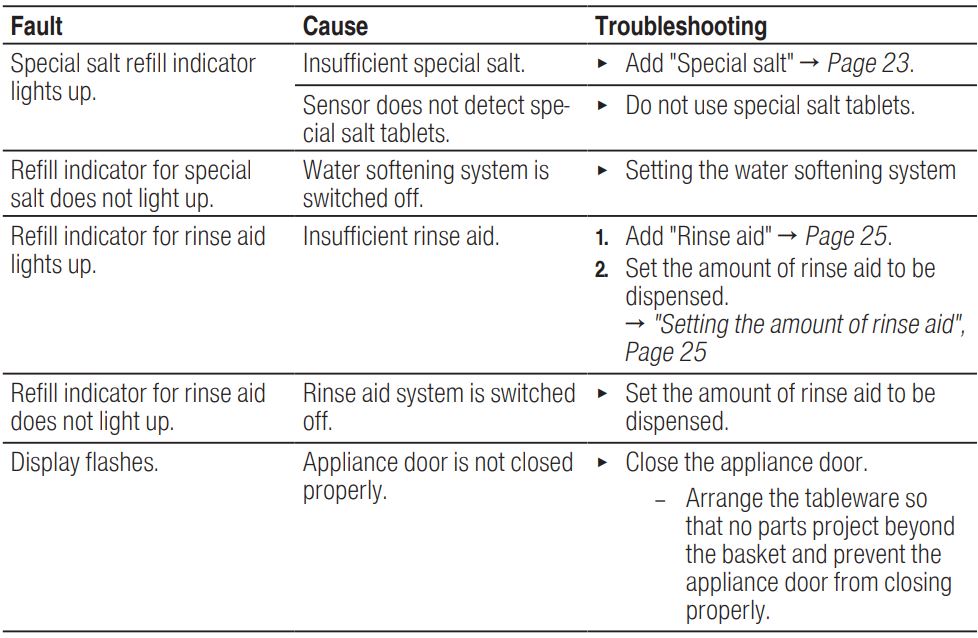
Malfunctions
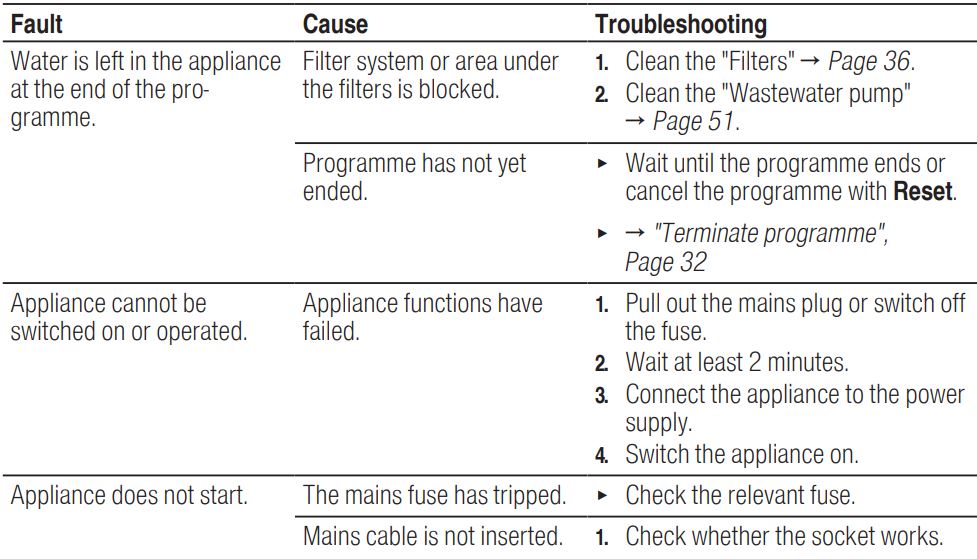

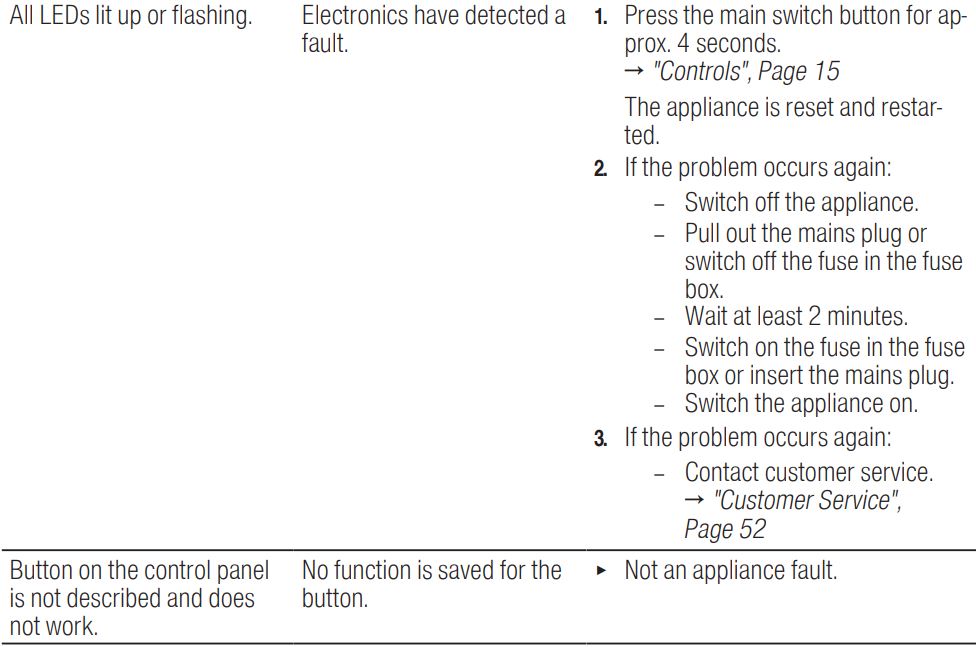
Mechanical damage
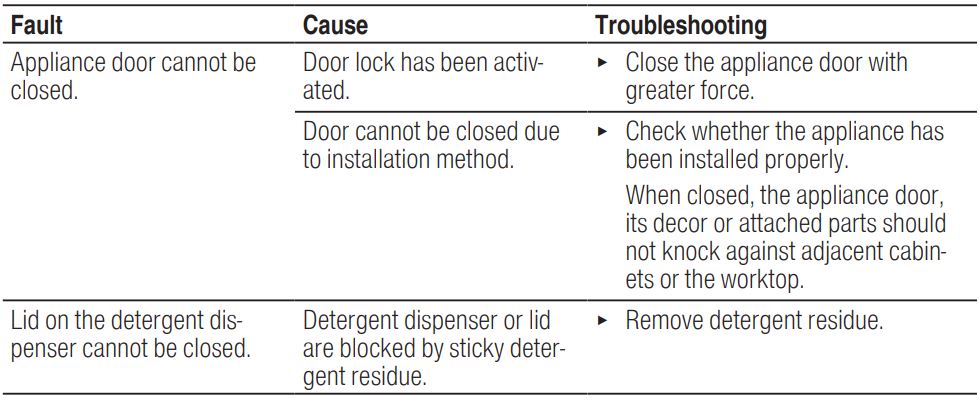
Noise

Clean wastewater pump
Large remnants of food or foreign bodies can block the waste water pump. As soon as the rinsing water no longer drains properly, the waste water pump must be cleaned.
⚠ WARNING Risk of injury!
Sharp and pointed objects or fragments of glass may block the waste water pump and cause injury. Remove any foreign bodies carefully.
- Disconnect the appliance from the power supply.
- Remove the top and bottom basket.
- Remove the filter system.
- Scoop out any water.
Use a sponge if necessary. - Prise off the pump cover using a spoon and grip it by the crosspiece.

- Lift the pump cover inwards at an angle and remove.
a You can now reach the impeller with your hand. - Remove any remnants of food and foreign bodies in the area of the impeller.
- Insert the pump cover and press down .

a The pump cover clicks into position. - Install the filter system. 10.Insert the top and bottom basket.
Transportation, storage and disposal
Removing the appliance
- Disconnect the appliance from the mains power supply.
- Turn off the water tap.
- Detach the drainage connection.
- Detach the drinking water connection.
- Loosen any screws fastening the appliance to cabinet parts.
- Remove the base panel if fitted.
- Pull the appliance out carefully, along with the hose behind it.
Protect appliance from frost
If there is a risk of frost where the appliance will be standing, e.g. in a holiday home, empty the appliance completely. Empty the appliance.
“Transporting the appliance”, Page 5
Transporting the appliance
To avoid damage to the appliance, empty it before transporting.
Note: Always transport the dishwasher upright to prevent residual water getting into the machine’s controls and damaging the appliance.
- Remove tableware from the appliance.
- Secure loose parts.
- “Switch on the appliance.” Page 30
- Select the programme with the highest temperature. “Programmes”, Page 17
- “Start the programme.” Page 31
- To drain the appliance, terminate the programme after approx. 4 minutes. “Terminate programme”, Page 32
- “Switch off the appliance.” Page 32
- Turn off the water tap.
- To empty the residual water out of the appliance, detach the supply hose and let the water drain out.
Disposing of old appliance
Valuable raw materials can be reused by recycling.
⚠ WARNING Risk of harm to health!
Children can lock themselves in the appliance, thereby putting their lives at risk. With redundant appliances, unplug the power cord. Then cut through the cord and damage the lock on the appliance door beyond repair so that the appliance door will no longer close.
- Unplug the appliance from the mains.
- Cut through the power cord. 3. Dispose of the appliance in an environmentally friendly manner. Information about current disposal methods are available from your specialist dealer or local authority.
![]() This appliance is labelled in accordance with European Directive 2012/19/EU concerning used electrical and electronic appliances (waste electrical and electronic equipment – WEEE). The guideline determines the framework for the return and recycling of used appliances as applicable throughout the EU.
This appliance is labelled in accordance with European Directive 2012/19/EU concerning used electrical and electronic appliances (waste electrical and electronic equipment – WEEE). The guideline determines the framework for the return and recycling of used appliances as applicable throughout the EU.
Customer Service
Function-relevant genuine spare parts according to the corresponding Ecodesign Order can be obtained from Customer Service for a period of at least 10 years from the date on which your appliance was placed on the market within the European Economic Area.
Note: Under the terms of the manufacturer’s warranty the use of Customer Service is free of charge. Detailed information on the warranty period and terms of warranty in your country is available from our aftersales service, your retailer or on our website. If you contact Customer Service, you will require the product number (ENr.), the production number (FD) and the consecutive numbering (Z-Nr.) of your appliance.
The contact details for Customer Service can be found in the enclosed Customer Service directory or on our website.
Product number (E-Nr.), production number (FD) and consecutive numbering (Z-Nr.)
You can find the product number (ENr.), the production number (FD) and the consecutive numbering (Z-Nr.) on the appliance’s rating plate. The rating plate is located inside the appliance door. Make a note of your appliance’s details and the Customer Service telephone number to find them again quickly.
AQUA-STOP guarantee
In addition to warranty claims against the seller under the purchase agreement and in addition to our manufacturer’s warranty, we offer compensation under the following conditions. ¡ If our Aqua-Stop system is defective and causes water damage, we will make good the damage for private users. To ensure protection from water damage, the appliance must be connected to the power supply. ¡ The liability guarantee is valid for the service life of the appliance. ¡ A claim can only be made under the guarantee if the appliance has been correctly installed and connected with Aqua-Stop according to our instructions; this also includes correctly fitting the Aqua Stop extension (genuine accessory). Our guarantee does not cover defective supply lines or fittings up to the Aqua-Stop connection on the tap. ¡ If your appliance is fitted with Aqua-Stop, you can in principle leave your appliance unattended during operation and the tap turned on afterwards. The tap only needs to be turned off if you are away from home for a long period, e.g. on holiday for several weeks.
Technical specifications
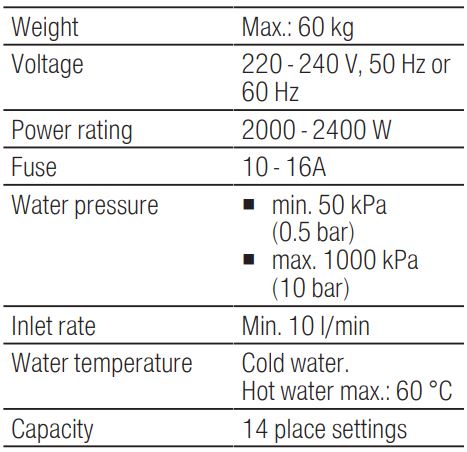
You can find more information about your model online at https://eprel.ec.europa.eu/1. This web address is linked to the official EU EPREL product database. Please then follow the instructions on searching for the model. The model identifier is made up of the characters before the slash in the product number (E-Nr.) on the rating plate. Alternatively, you can also find the model identifier in the first line of the EU energy label.
Information regarding Free and Open Source Software
This product includes software components that are licensed by the copyright holders as free or open source software. The applicable licence information is stored on your home appliance. You can also access the applicable licence information via your Home Connect app: “Profile -> Legal information -> Licence Information”.1 You can download the licence information on the brand product website. (Please search on the product website for your appliance model and additional documents). Alternatively, you can request the relevant information from [email protected] or BSH Hausgeräte GmbH, Carl-Wery-Str. 34, 81739 Munich, Germany. The source code will be made available to you on request. Please send your request to [email protected] or BSH Hausgeräte GmbH, Carl-Wery-Str.34, 81739 Munich, Germany. Subject: ,,OSSREQUEST” The cost of performing your request will be charged to you. This offer is valid for three years from the date of purchase or at least as long as we offer support and spare parts for the relevant appliance.
1 Depending on the appliance specifications 54
![]()
 Thank you for buying a Bosch Home Appliance!
Thank you for buying a Bosch Home Appliance!
Register your new device on MyBosch now and profit directly from:
- Expert tips & tricks for your appliance
- Warranty extension options
- Discounts for accessories & spare-parts
- Digital manual and all appliance data at hand
- Easy access to Bosch Home Appliances Service
Free and easy registration also on mobile phones: www.bosch-home.com/welcome
 Looking for help? You’ll find it here.
Looking for help? You’ll find it here.
Expert advice for your Bosch home appliances, help with problems or a repair from Bosch experts. Find out everything about the many ways Bosch can support you: www.bosch-home.com/service Contact data of all countries are listed in the attached service directory.
BSH Hausgeräte GmbH Carl-Wery-Straße 34 81739 München, GERMANY www.bosch-home.com
A Bosch Company
 Valid within Great Britain: Imported to Great Britain by BSH Home Appliances Ltd. Grand Union House Old Wolverton Road Wolverton, Milton Keynes MK12 5PT United Kingdom
Valid within Great Britain: Imported to Great Britain by BSH Home Appliances Ltd. Grand Union House Old Wolverton Road Wolverton, Milton Keynes MK12 5PT United Kingdom
Download PDF
BOSCH SGV4HCX48E Dishwasher User Manual PDF Download
